2019 HYUNDAI SONATA HYBRID warning light
[x] Cancel search: warning lightPage 12 of 546
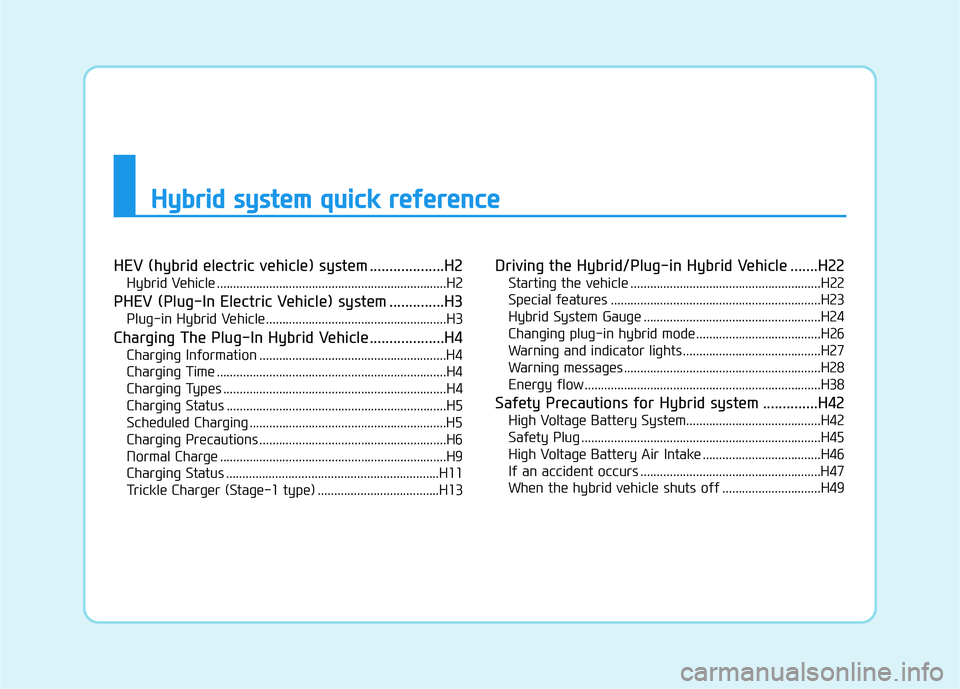
HHyybbrriidd ss yy ssttee mm qq uu iicc kk rr ee ffee rree nn ccee
HEV (hybrid electric vehicle) system ...................H2
Hybrid Vehicle ......................................................................H2
PHEV (Plug-In Electric Vehicle) system ..............H3 Plug-in Hybrid Vehicle.......................................................H3
Charging The Plug-In Hybrid Vehicle ...................H4 Charging Information .........................................................H4
Charging Time ......................................................................H4
Charging Types ....................................................................H4
Charging Status ...................................................................H5
Scheduled Charging ............................................................H5
Charging Precautions .........................................................H6
Normal Charge .....................................................................H9
Charging Status .................................................................H11
Trickle Charger (Stage-1 type) .....................................H13 Driving the Hybrid/Plug-in Hybrid Vehicle .......H22
Starting the vehicle ..........................................................H22
Special features ................................................................H23
Hybrid System Gauge ......................................................H24
Changing plug-in hybrid mode ......................................H26
Warning and indicator lights ..........................................H27
Warning messages ............................................................H28
Energy flow ........................................................................H38
Safety Precautions for Hybrid system ..............H42 High Voltage Battery System.........................................H42
Safety Plug .........................................................................H45
High Voltage Battery Air Intake ....................................H46
If an accident occurs .......................................................H47
When the hybrid vehicle shuts off ..............................H49
Page 18 of 546
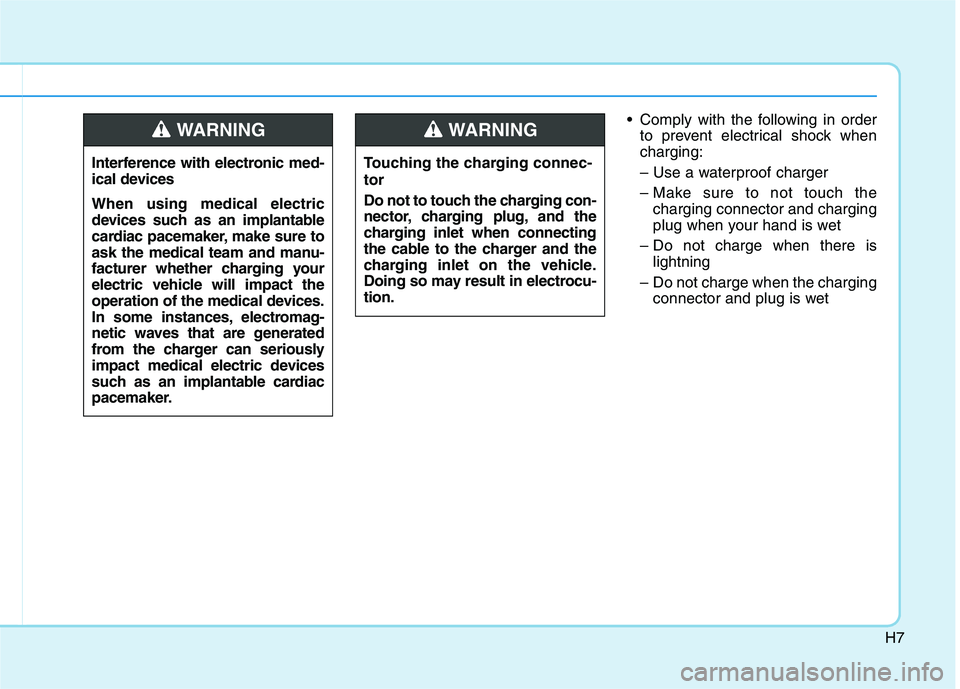
H7
Comply with the following in orderto prevent electrical shock when charging:
– Use a waterproof charger
– Make sure to not touch thecharging connector and charging
plug when your hand is wet
– Do not charge when there is lightning
– Do not charge when the charging connector and plug is wet
Touching the charging connec- tor
Do not to touch the charging con-
nector, charging plug, and the
charging inlet when connecting
the cable to the charger and the
charging inlet on the vehicle.
Doing so may result in electrocu-tion.WARNING
Interference with electronic med-
ical devices When using medical electric
devices such as an implantable
cardiac pacemaker, make sure to
ask the medical team and manu-
facturer whether charging your
electric vehicle will impact the
operation of the medical devices.
In some instances, electromag-
netic waves that are generated
from the charger can seriously
impact medical electric devices
such as an implantable cardiac
pacemaker.
WARNING
Page 31 of 546
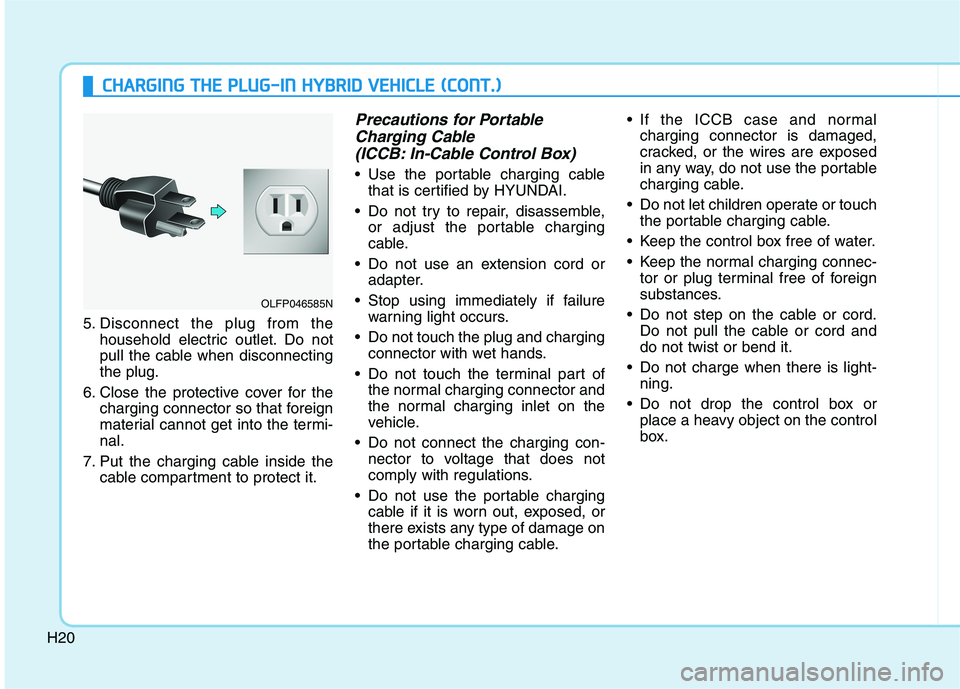
H20
CCHH AARRGG IINN GG TT HH EE PP LLUU GG--IINN HH YY BBRRIIDD VV EEHH IICC LLEE (( CC OO NNTT..))
5. Disconnect the plug from the
household electric outlet. Do not
pull the cable when disconnectingthe plug.
6. Close the protective cover for the charging connector so that foreign
material cannot get into the termi-nal.
7. Put the charging cable inside the cable compartment to protect it.
Precautions for Portable
Charging Cable
(ICCB: In-Cable Control Box)
Use the portable charging cable that is certified by HYUNDAI.
Do not try to repair, disassemble, or adjust the portable charging
cable.
Do not use an extension cord or adapter.
Stop using immediately if failure warning light occurs.
Do not touch the plug and charging connector with wet hands.
Do not touch the terminal part of the normal charging connector and
the normal charging inlet on the
vehicle.
Do not connect the charging con- nector to voltage that does not
comply with regulations.
Do not use the portable charging cable if it is worn out, exposed, or
there exists any type of damage on
the portable charging cable. If the ICCB case and normal
charging connector is damaged,
cracked, or the wires are exposed
in any way, do not use the portable
charging cable.
Do not let children operate or touch the portable charging cable.
Keep the control box free of water.
Keep the normal charging connec- tor or plug terminal free of foreign
substances.
Do not step on the cable or cord. Do not pull the cable or cord anddo not twist or bend it.
Do not charge when there is light- ning.
Do not drop the control box or place a heavy object on the control
box.
OLFP046585N
Page 33 of 546
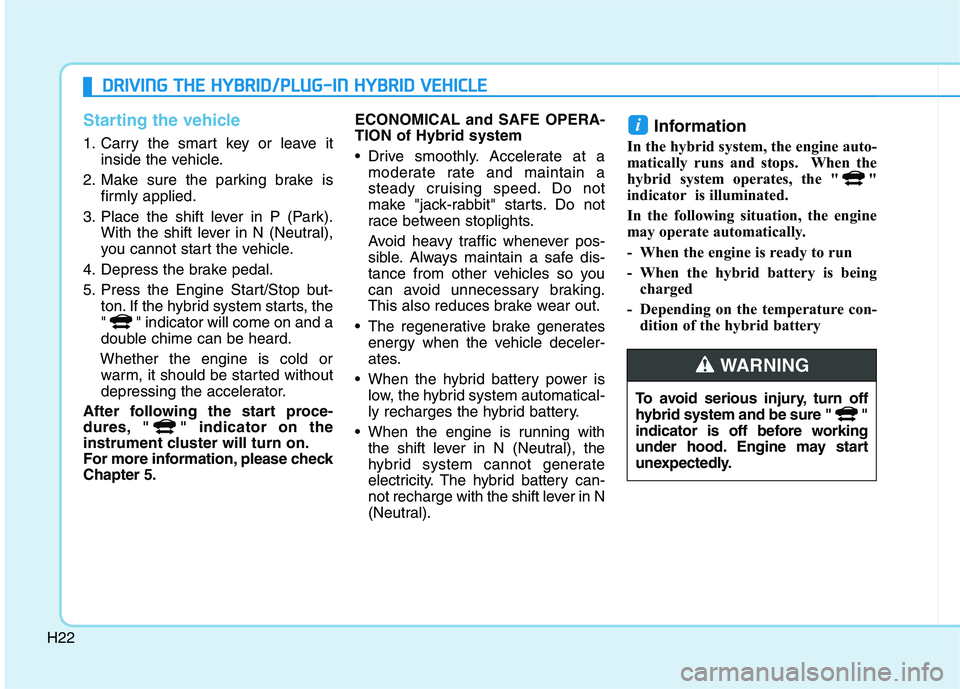
H22
DDRRIIVV IINN GG TT HH EE HH YY BBRRIIDD //PP LLUU GG--IINN HH YY BBRRIIDD VV EEHH IICC LLEE
Starting the vehicle
1. Carry the smart key or leave it
inside the vehicle.
2. Make sure the parking brake is firmly applied.
3. Place the shift lever in P (Park). With the shift lever in N (Neutral),
you cannot start the vehicle.
4. Depress the brake pedal.
5. Press the Engine Start/Stop but- ton. If the hybrid system starts, the
" " indicator will come on and a
double chime can be heard.
Whether the engine is cold or warm, it should be started without
depressing the accelerator.
After following the start proce-
dures, " " indicator on the
instrument cluster will turn on.
For more information, please checkChapter 5. ECONOMICAL and SAFE OPERA- TION of Hybrid system
Drive smoothly. Accelerate at a
moderate rate and maintain a
steady cruising speed. Do not
make "jack-rabbit" starts. Do not
race between stoplights.
Avoid heavy traffic whenever pos-
sible. Always maintain a safe dis-
tance from other vehicles so you
can avoid unnecessary braking.
This also reduces brake wear out.
The regenerative brake generates energy when the vehicle deceler-
ates.
When the hybrid battery power is low, the hybrid system automatical-
ly recharges the hybrid battery.
When the engine is running with the shift lever in N (Neutral), the
hybrid system cannot generate
electricity. The hybrid battery can-
not recharge with the shift lever in N
(Neutral). Information
In the hybrid system, the engine auto-
matically runs and stops. When the
hybrid system operates, the " "
indicator is illuminated.
In the following situation, the engine
may operate automatically.
- When the engine is ready to run
- When the hybrid battery is being charged
- Depending on the temperature con- dition of the hybrid battery
i
To avoid serious injury, turn off
hybrid system and be sure " "
indicator is off before working
under hood. Engine may start
unexpectedly.
WARNING
Page 38 of 546
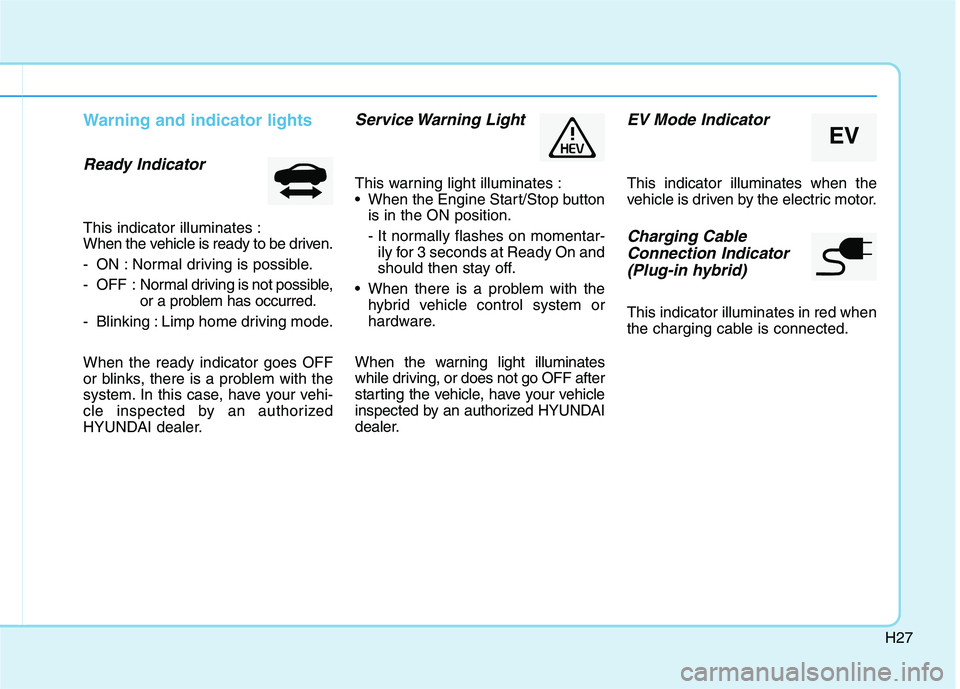
H27
Warning and indicator lights
Ready Indicator
This indicator illuminates :
When the vehicle is ready to be driven.
- ON : Normal driving is possible.
- OFF : Normal driving is not possible,
or a problem has occurred.
- Blinking : Limp home driving mode. When the ready indicator goes OFF
or blinks, there is a problem with the
system. In this case, have your vehi-
cle inspected by an authorized
HYUNDAI dealer.
Service Warning Light
This warning light illuminates :
When the Engine Start/Stop button is in the ON position.
- It normally flashes on momentar-ily for 3 seconds at Ready On and
should then stay off.
When there is a problem with the hybrid vehicle control system or
hardware.
When the warning light illuminates
while driving, or does not go OFF after
starting the vehicle, have your vehicle
inspected by an authorized HYUNDAI
dealer.
EV Mode Indicator
This indicator illuminates when the
vehicle is driven by the electric motor.
Charging Cable Connection Indicator (Plug-in hybrid)
This indicator illuminates in red when
the charging cable is connected.
EV
Page 39 of 546
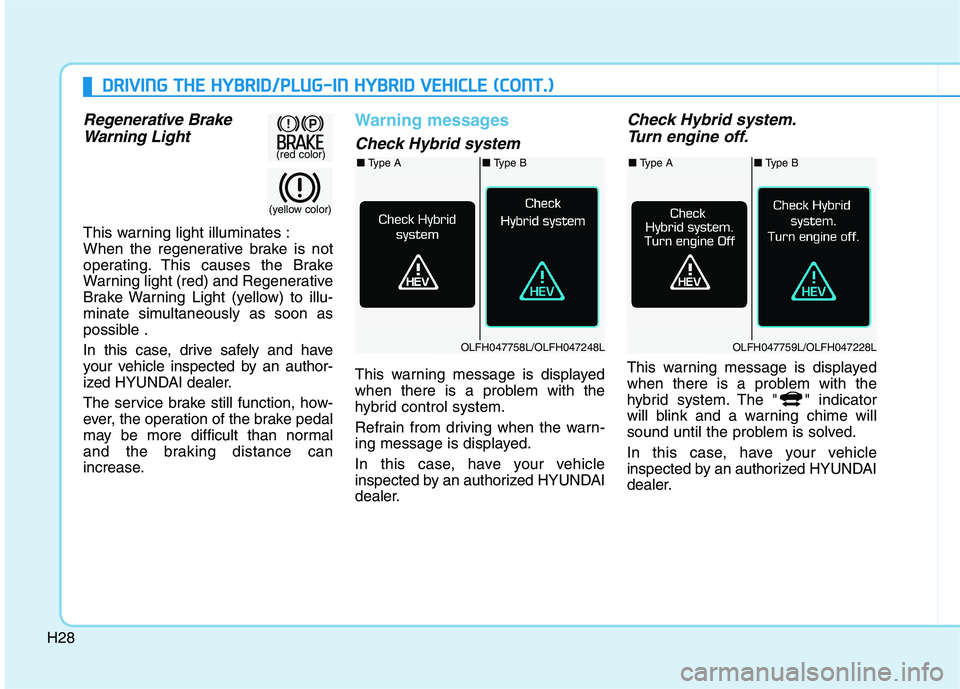
H28
DDRRIIVV IINN GG TT HH EE HH YY BBRRIIDD //PP LLUU GG--IINN HH YY BBRRIIDD VV EEHH IICC LLEE (( CC OO NNTT..))
Regenerative Brake
Warning Light
This warning light illuminates :
When the regenerative brake is not
operating. This causes the Brake
Warning light (red) and Regenerative
Brake Warning Light (yellow) to illu-
minate simultaneously as soon as
possible .
In this case, drive safely and have
your vehicle inspected by an author-
ized HYUNDAI dealer.
The service brake still function, how-
ever, the operation of the brake pedal
may be more difficult than normal
and the braking distance can
increase.
Warning messages
Check Hybrid system
This warning message is displayed
when there is a problem with the
hybrid control system.
Refrain from driving when the warn-
ing message is displayed.
In this case, have your vehicle
inspected by an authorized HYUNDAI
dealer.
Check Hybrid system.Turn engine off.
This warning message is displayed
when there is a problem with the
hybrid system. The " " indicator
will blink and a warning chime will
sound until the problem is solved.
In this case, have your vehicle
inspected by an authorized HYUNDAI
dealer.
(yellow color)
(red color)■ Type A■ Type B
OLFH047758L/OLFH047248L
■ Type A■ Type B
OLFH047759L/OLFH047228L
Page 67 of 546
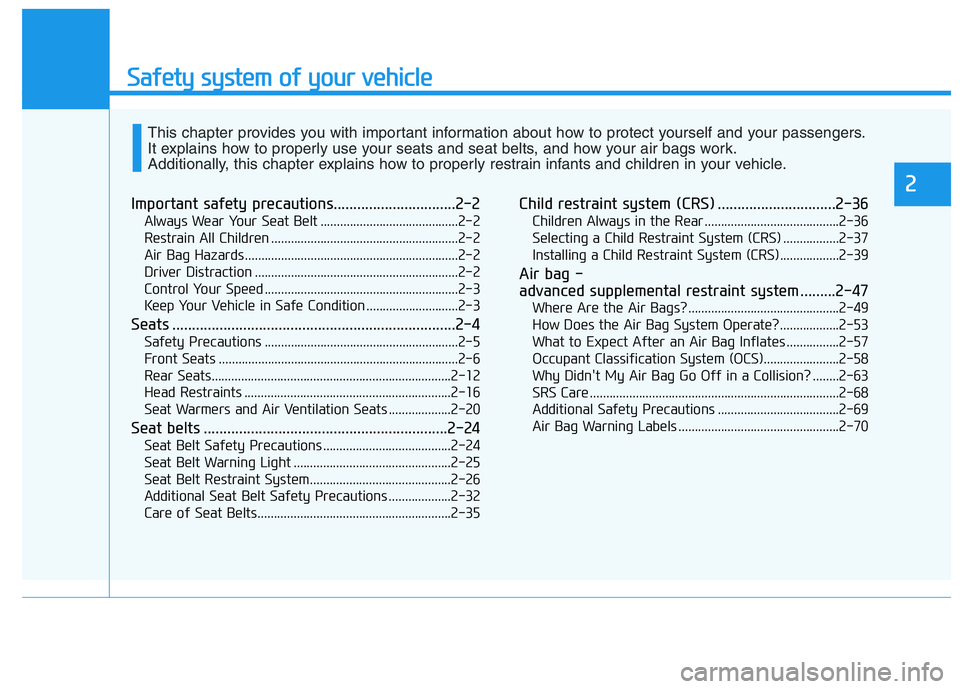
Safety system of your vehicle
Important safety precautions...............................2-2Always Wear Your Seat Belt ..........................................2-2
Restrain All Children .........................................................2-2
Air Bag Hazards .................................................................2-2
Driver Distraction ..............................................................2-2
Control Your Speed ...........................................................2-3
Keep Your Vehicle in Safe Condition ............................2-3
Seats ........................................................................2-4 Safety Precautions ...........................................................2-5
Front Seats .........................................................................2-6
Rear Seats.........................................................................2-12
Head Restraints ...............................................................2-16
Seat Warmers and Air Ventilation Seats ...................2-20
Seat belts ..............................................................2-24 Seat Belt Safety Precautions .......................................2-24
Seat Belt Warning Light ................................................2-25
Seat Belt Restraint System...........................................2-26
Additional Seat Belt Safety Precautions ...................2-32
Care of Seat Belts...........................................................2-35 Child restraint system (CRS) ..............................2-36
Children Always in the Rear .........................................2-36
Selecting a Child Restraint System (CRS) .................2-37
Installing a Child Restraint System (CRS)..................2-39
Air bag -
advanced supplemental restraint system .........2-47 Where Are the Air Bags? ..............................................2-49
How Does the Air Bag System Operate?..................2-53
What to Expect After an Air Bag Inflates ................2-57
Occupant Classification System (OCS).......................2-58
Why Didn't My Air Bag Go Off in a Collision? ........2-63
SRS Care ............................................................................2-68
Additional Safety Precautions .....................................2-69
Air Bag Warning Labels .................................................2-70
This chapter provides you with important information about how to protect yourself and your passengers.
It explains how to properly use your seats and seat belts, and how your air bags work.
Additionally, this chapter explains how to properly restrain infants and children in your vehicle.
2
Page 72 of 546
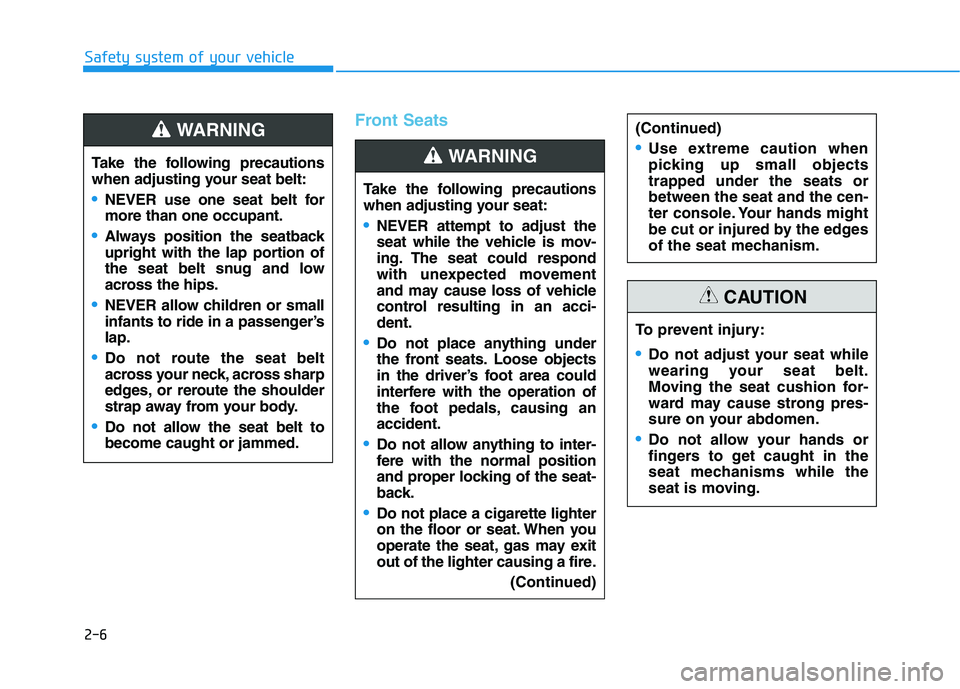
2-6
Safety system of your vehicle
Front Seats
Take the following precautions
when adjusting your seat belt:
NEVER use one seat belt for more than one occupant.
Always position the seatback
upright with the lap portion of
the seat belt snug and low
across the hips.
NEVER allow children or small
infants to ride in a passenger’slap.
Do not route the seat belt
across your neck, across sharp
edges, or reroute the shoulder
strap away from your body.
Do not allow the seat belt to become caught or jammed.
WARNING
Take the following precautions
when adjusting your seat:
NEVER attempt to adjust the
seat while the vehicle is mov-
ing. The seat could respond
with unexpected movement
and may cause loss of vehicle
control resulting in an acci-dent.
Do not place anything under
the front seats. Loose objects
in the driver’s foot area could
interfere with the operation of
the foot pedals, causing anaccident.
Do not allow anything to inter-
fere with the normal position
and proper locking of the seat-
back.
Do not place a cigarette lighter
on the floor or seat. When you
operate the seat, gas may exit
out of the lighter causing a fire.(Continued)
WARNING
To prevent injury:
Do not adjust your seat while
wearing your seat belt.
Moving the seat cushion for-
ward may cause strong pres-
sure on your abdomen.
Do not allow your hands or
fingers to get caught in the
seat mechanisms while the
seat is moving.
CAUTION
(Continued)
Use extreme caution when
picking up small objectstrapped under the seats orbetween the seat and the cen-
ter console. Your hands might
be cut or injured by the edges
of the seat mechanism.